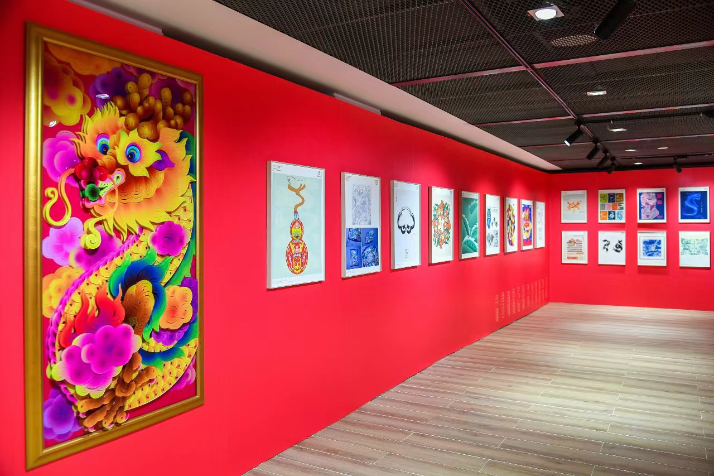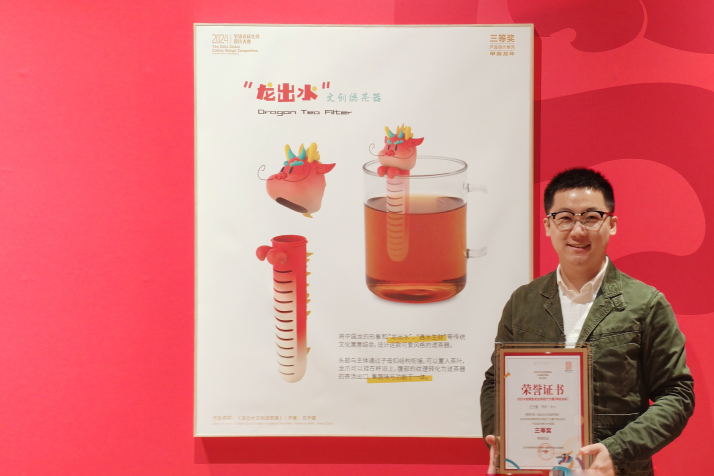| Lifestyle |
| Ideas abound for young designers in China | |
|
|
 The Rainbow Auspicious Dragon paper cutting (first left) on display at the Beijing Overseas Cultural Exchange Center on December 21, 2023 (WEI YAO)
The Year of the Dragon comes with inspiration for fierce creativity, as well as the power to bring big ideas to life. Designer Wang Zijian's Dragon Out of Water, a creative tea infuser, shines on the wall at the exhibition of the winning works of the 2024 Global Zodiac Design Competition at the Beijing Overseas Cultural Exchange Center (BOCEC). Its cute dragon design and special function are bound to appeal to young consumers. "It's a unique product, and we expect a positive response from young customers," Wang told Beijing Review. The item belongs to the China Chic category. China Chic, or guochao (which literally translates as "national wave"), which refers to products of all sorts incorporating traditional Chinese cultural elements. These products have been embraced by the country's younger generations in recent years. According to a report by Xinhua News Agency, Gen Z accounted for 74 percent of consumers of China Chic goods in 2022, and the search volume of China Chic products has increased fivefold over the past decade. On DeWu, an e-commerce platform, young customers are fascinated by goods related to Dunhuang, an important city on the ancient Silk Road, Sanxingdui, an archaeological site unveiling a Bronze Age civilization in the southwestern province of Sichuan, and traditional auspicious animals, including dragons. As a young designer, Wang hopes to capture young consumers with his creative rendering of dragons. "I've been thoroughly studying the dragon's historical connotations and the Gen Z consumer psychology," the 34-year-old designer told Beijing Review. A global gradient Instead of using pure red for the dragon, which is common in Chinese design history, Wang opted for a gradient red color palette. "Gen Z consumers are in love with gradient color palettes and moving ornaments. The dragon's body becomes lighter as it stretches into the cup, as if the tea is washing off its color. The beard, then, is basically a flexible tube, so consumers can move it around and create a sense of interaction," said Wang. He is no stranger to the integration of traditional culture and the needs of young clienteles. In 2018, he created a hand cream for tourists in Xi'an, Shaanxi Province, his hometown. As the capital of 13 dynasties in ancient times, Xi'an features a host of prestigious tourist attractions, including the Terracotta Warriors, Beilin Museum and Dayan Pagoda. To meet the needs of culture lovers, Wang created a hand cream inspired by historical relics, including paintings and objects from ancient China. "The product has been a hit, with positive feedback pouring in since its debut," Wang told Beijing Review, adding, "Young female customers especially love it. The shape of the cream set box is inspired by the zhuang-lian, the makeup box popular in the Tang Dynasty (618-907). And the packaging of each cream features floral patterns seen in famous Chinese paintings," Wang said. Wang also took into consideration the needs of an international audience. "In Western literature, the dragons are often portrayed as immensely formidable creatures. But the dragon I designed is cute and friendly, with its chubby round face, big eyes, and the way it leans on the edge of the teacup and sticks its head out of the water," the designer explained, adding that he is working to gradually change the stereotypes of Chinese dragons held by Western audiences. Wang further considers the difference in tea culture between East and West. "Traditional tea lovers in China don't use tea infusers because they like to admire the movement of the tea in the cup," Wang said. "I think international customers will like this infuser because it is environmentally friendly—literally a 'tea bag' that can be used thousands of times. It saves both plastic and paper." Despite his bold steps toward change, Wang did retain the essential elements of traditional Chinese dragons. "People will recognize it as a Chinese dragon at first glance," Wang said. In line with Chinese mythology, Wang's dragon has the horns of a deer, the head of a camel, the eyes of a rabbit, the scales of a fish, the ears of an ox and the paws of a tiger. "I'm trying to strike a balance between keeping its traditional cultural connotation and making it popular and acceptable for young and international customers. I don't want it to be subjected to fast-moving consumer trends; it's still a China Chic product," Wang said.  Wang Zijian holds up his award certificate next to his work at the Beijing Overseas Cultural Exchange Center on December 21, 2023 (ZHANG YAGE)
Rich in life Cui Xiaoqing, another third prize winner of the 2024 Global Zodiac Design Competition and co-organizer of Paper Plus, a traditional Chinese paper cutting brand, was recognized by the committee for his creative product Rainbow Auspicious Dragon. Cui is adept at using traditional elements to express modern attitudes. In his Rainbow Auspicious Dragon paper cutting calendar, he mixed the actual image of the dragon with a matrix of traditional elements, including auspicious clouds, a sea-shaped pattern, a cliff-shaped pattern and a drop-shaped pattern. He used a palette of bright colors including purple, red, pink, orange, blue, and green to complete a confident, optimistic and friendly looking dragon that is slightly different from the traditional depiction of the mythical creature. "Holding on to the connection between the dragon and imperial authority, many artists in ancient China created the dragon's profile as dominant, noble and authentic. But people's concepts change with time, and so my dragon resonates with modern Chinese aspirations to embrace diversity, pursue peaceful coexistence and create a global community," Cui told Beijing Review. Beginning in the Han Dynasty (202 B.C.-A.D. 220), the dragon came to symbolize the emperor. Liu Bang, the first Han emperor, was claimed to be the true heir of the dragon in the Book of Han, considered the Confucian historiographic model on which all later dynastic histories were patterned. Dragons featured prominently in palace decorations, patterns on the emperor's clothing, and the jade seals the emperor used to issue orders. While giving new meaning to traditional elements, Cui has intensified efforts to prolong the vitality of Chinese paper cutting by applying the latest technologies and promoting it among the wider public. Paper cutting is a traditional decorative art that uses scissors or knives to cut patterns out of paper. Women used foil and silk to cut out flowers and birds and pasted them on their hair as early as the Han and Tang dynasties. Later, the paper cuttings were used to decorate windows during festivals, depicting plants, animals and Chinese characters. In 2009, the Chinese art was included in UNESCO's Intangible Cultural Heritage List. "Delicate art comes at a higher price," Cui explained. "And that price tag is what drives a lot of people away; it's also one of the reasons why many similar intangible cultural heritages have died out. I don't want that to happen to the art of paper cutting." "Paper cutting is very time-consuming, and the effort that goes into it results in higher price tags. But thanks to the latest technologies, such as laser engraving, designers can make the works affordable again," he added. According to Cui, his dragon calendar has the power to lift its onlooker's mood. "The calendar, with the dragon's body flowing through the months, has a festive connotation throughout the year. It can brighten up any day of the week," Cui said. "It's in the Chinese DNA to be romantic and create a sense of ritual—even in the smallest of things. I would like to pay tribute to our romantic ancestors who invented the art of paper cutting, dig into traditional Chinese culture and lend the art contemporary verve," Cui concluded. Copyedited by Elsbeth van Paridon Comments to zhangyage@cicgamericas.com |
|
||||||||||||||||||||||||||||
|
